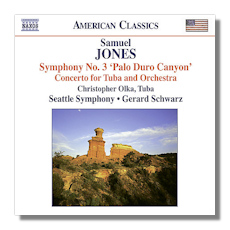
The Internet's Premier Classical Music Source
Related Links
- Latest Reviews
- More Reviews
-
By Composer
-
Collections
DVD & Blu-ray
Books
Concert Reviews
Articles/Interviews
Software
Audio
Search Amazon
Recommended Links
Site News
 CD Review
CD Review
Samuel Jones

- Symphony #3 "Palo Duro Canyon" (23:39)
- Concerto for Tuba & Orchestra (23:57)
Christopher Olka, tuba
Seattle Symphony Orchestra/Gerard Schwarz
Naxos American Classics 8.559378
These are both neo-romantic works. Samuel Jones studied with Howard Hanson and it shows. In the concerto there are a couple of brief moments reminiscent of Mahler and Jones actually quotes Wagner. The symphony begins with the kind of rushing notes that Sibelius used so frequently. However, Jones certainly has his own voice, and both the concerto and the symphony show his inventiveness.
The 2006 concerto, which comes first on the disc, opens briefly with the soloist playing the kind of simple figure you might anticipate from his instrument but it immediately grows into an unexpectedly lyrical melody. In much of the concerto the tuba plays softly and as part of the ensemble, though as a prominent voice always. When a high trumpet plays over the low tuba what is most noticeable is the wide pitch range of a contrapuntal passage. Other instances of this are a hushed legato passage with the violins playing softly over a quiet tuba in the second movement and a high flute or perhaps piccolo over soft low notes in the third.
The scoring is for a substantial ensemble and the orchestra has plenty to say throughout. There are loud vigorous sections, with some tension, especially in the first movement, including some clanging percussion. The commentator, Steven Lowe hears the first movement as fiercer than I do. There surely are some strong contrasts, to be sure.
Jones likes dynamic contrast as well as extremes of pitch. The middle movement is both loud and soft. In the finale there are some notable rising and falling scale passages. An unusual effect in the finale is a wind tunnel sound, a tribute to James P. Crowder, an aeronautical engineer and an amateur tuba player, in whose memory the work was commissioned and who worked with flow visualization of rapidly moving air on solid surfaces, as the notes relate.
The concerto's pace is more slow than fast: Movement 1 is Andante con moto, Movement 2 Andante mosso – Adagietto, and the finale begins Largo before shifting to Allegro molto. The fast passages are notable for some very agile fluttering playing by Olka, who has a nice tone throughout. (A personal disclosure: the bass tuba was my own instrument long ago and I never dreamed that a tuba player would have a songful concerto like this to play.)
THE SYMPHONY is in a single movement, though with discernible sections. The symphony begins with a tape of actual blowing wind. The orchestra's winds and strings swoop also. Some of the music sounds mysterious. Early on it takes a solemn, even exalted mood, with plenty of brass and percussion but not just at high volume. There is a bass tread that is fairly soft. As in the concerto there is a wide dynamic and pitch range; the bass is often prominent, sometimes with a high trumpet or horn over it. Jones uses a large orchestra in this work also, sometimes sparingly. At the end, which is beautiful, very gentle, bell-like – even liquid-sounding – percussion is heard.
The subtitle of this work relates to its commission by the Amarillo Symphony. The Palo Duro Canyon is a natural wonder in the flat Texas panhandle. The 1992 première was at an outdoor amphitheater and there was a public television broadcast featuring the work, but I did not see it. Concerning the work, Jones said that he wanted it to have many layers of sound and meaning, including an expression of the huge length of time that went into the formation of the canyon. He also was paying homage to Native Americans for whom the canyon was sacred.
There is some beautiful music here and all this music is well worth hearing.
Copyright © 2009, R. James Tobin




















